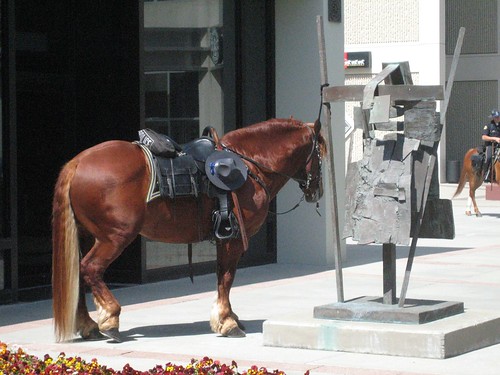If you have a few minutes, click through Thomas Hawk’s, flickr set “Graffiti, Stencils and Public Murals and Art.”
Purls of wisdom
There has been a slew of radical textile projects of late, it seems, although there is always a longer history than we realize:

Germaine Koh’s Knitwork, which she describes as a lifeling project, began in 1992. Periodically, Germaine makes an appointment with the registrar at the Art Gallery of Ontario to knit one purl two, adding to her work. More recently, see Cat Mazza’s microRevolt; Rachel Beth Egenhoefer’s KNiiTTiiNG – knitting for the Ninetendo Wii and virtual knitting; which reminds me of Stephanie Rothenberg and Jeff Crouse’s Invisible Threads.
And there are many, many other projects, but spurred by Forecaster2’s Overview of Nouveau Graffiti, I want to call attention to the blog on Etsy about Magda Sayeg’s Knitta. The intro about “tomasons” is worth quoting:
“‘The apartment I moved into has a tomason,’ said Rachel, my friend Tom’s girlfriend. ‘A what?’ I asked, thinking it was some sort of poltergeist. ‘It’s this old, weird metal thing sticking out of the wall,’ Rachel explained. ‘I’m not sure, but I think it used to be a fixture when there were gas lights.’ ‘A tomason,’ my friend Tom, a book editor, followed up, ‘is a word coined by a Japanese artist Genpei Akasegawa. It’s in this book I’m publishing in June called Portrait with Keys by Ivan Vladislavić.’ According to Wikipedia, Genpei Akasegawa used this word to refer to useless street objects that happen to look like conceptual art.
Tomasons are a little more banal that ghosts, and I’ve found them much easier to spot, now that this unlikely word is in my head. Tomasons now appear before me on my daily walk to work. Before I hadn’t noticed them; they’d flowed together in the continuous stream of my peripheral vision. It occurred to me that they are part of what makes up our general experience of grit and urban decay. An army of tomasons stands silently at attention, arming the city with strong stuff like metal poles and concrete abutments. And then one day, out of the blue, a steel door handle is decked out in a brightly colored knit cozy.
Sayeg uses her knitting to “tag” tomasons!
Who wouldn’t want to work with Ann Hamilton?
Experiment in Art, Design and Architecture in the Landscape
Led by Ann Hamilton and Michael Mercil
June 14-30, 2009
http://www.arch.wustl.edu/Summer_Programs
Saint Louis Art! Revolution is a three-week experimental field lab and collaborative workshop at the Sam Fox School of Design & Visual Arts and Pulitzer Foundation for the Arts.
Participants will examine issues of place and site, history and memory, materiality and construction, sound and motion, through parallel, in-depth investigations into three historically significant sites in St. Louis: the Cahokia Mounds, the Gateway Arch and Archgrounds, and the Pulitzer Foundation for the Arts.
Our investigations will form the basis for collaborative interpretive project exploring varied media and forms—emphasizing the archaeology, history, culture, ecology, and fictional aspects of the metropolitan St. Louis landscape.
The workshop is open to students and professionals with backgrounds across the fields of art, architecture, design, landscape architecture, urban design, and the humanities and natural sciences. Rising seniors, post-BFA or B.Arch, MFA, M.Arch, M.L.A. students, as well as practitioners in these fields are welcome to apply.
“SAINT LOUIS ART! REVOLUTION, wherever we are it will be.”
Non- “FLOS” public space and aesthetic invention
Are the iPhone and iPod Touch new spheres for public art?
Bloom iPhone Application from Lawrence Brown on Vimeo.
The question is more than whether you like a particular aesthetic app on your device, such as Bloom or Buddha Machine, but how does the controlled space of the iPhone and iPod and their app store constitute a public sphere for artistic intervention?
Some might argue that as closed, legally controlled systems, the devices do not truly constitute “public space.” On the other hand, from Linda Benglis’s magazine ads to Giselle Beiguelman’s interactive billboard art to Dara Birnbaum’s Rio Videowall for an Atlanta shopping mall to the world-making in corporate controlled Second Life, there are numerous examples of important experiments by artists in legally constricted but nevertheless functionally public spaces. It is crtical, however, to always keep in mind that these spaces are not what one might call FLOS – Free/Libre/Open Source – spaces.
 Recently, Tiny Wonder Studios releaased Pixi for the iPhone and iPod touch. According to it website:
Recently, Tiny Wonder Studios releaased Pixi for the iPhone and iPod touch. According to it website:
“Tiny Wonder Studios is on a mission to create tiny miracles for the iPhone. Using nanotechnology, our patented “chaos processâ€, and very small screwdrivers, we lovingly craft the finest stuff for your mobile enjoyment.”
The first Tiny Wonder release is Pixi, which they “introduce:”
“Meet Pixi. Create infinite animated spirals of color and light by touching your screen. It’s magical. It’s mesmerizing. It’s music for your eyes. Pixi is simple to use, but you’ll find endless ways to express yourself the deeper you explore.”
Pixi is a bit like creating your own screensaver and can be mesmerizing, although, since I don’t use my iPod Touch as an ambient device – visually – it hasn’t, yet, migrated to my first screen of most-used apps.
In a conversation with Lawrence Bricker, a “film school graduate and lead geek” of Tiny Wonder Studios, he demonstrated a prototype version 2.0 that used the network to share Pixi creations and even locate nearby users in real time.
 Personally, I’d like to see Pixi as a multi-storey display on the Target headquarters building in downtown Minneapolis and be able to modify it from my iPhone (which I plan to buy when Apple no longer forces me into a device-marriage with ATT, speaking of non-FLOS public space . . . ), like a Twin Cities version of Rafael Lozano-Hemmer’s Vectorial Elevation.
Personally, I’d like to see Pixi as a multi-storey display on the Target headquarters building in downtown Minneapolis and be able to modify it from my iPhone (which I plan to buy when Apple no longer forces me into a device-marriage with ATT, speaking of non-FLOS public space . . . ), like a Twin Cities version of Rafael Lozano-Hemmer’s Vectorial Elevation.
Mostly, however, Pixi makes me think of some kind of Moore’s law of aesthetic invention, where what decades ago Dan Sandin or John Whitney might have labored over for months or even years is now accessible in my pocket with the flick of a finger. That’s an interesting kind of progress, which like un-FLOS public space can’t simply be ignored.
via videosift.com
“In PERMUTATIONS, each point moves at a different speed and moves in a direction independent according to natural laws’ quite as valid as those of Pythagoras, while moving in their circular field. Their action produces a phenomenon more or less equivalent to the musical harmonies. When the points reach certain relationships (harmonic) numerical to other parameters of the equation, they form elementary figures.”
– John Whitney
Hitching Up to Public Art
How can you not love this experiment with art in public places?
btw, here is the San Jose version of Portland’s horse project. In San Jose the local constabulary like to hitch up to public art when they stop for a latte at Starbucks. 😉
[deli.ci.us bookmarks] 11.12.08
Welcome to eclectic avenue
"The festival explores the notion of urban space in a temporal and mobile way," curator St/(c)phane Bertrand said. "It's an exchange between residents and artists based on the themes of gesture, movement and infiltration into the everyday."
Anish Kapoor Opens London's New 'Gallery Without Walls' – 24 Hour Museum
t heralds what promises to be an new era for public art
Abstract Public Art Bike Rack I – Reno, NV – Bicycle Tenders on Waymarking.com
Abstract (Green) Public Art Bike Rack in downtown Reno, Nevada
MinnPost – From Our Partners: Walker Art Center: The UnConvention: unscripting the political convention
"We're working with artists who are very adept at creating powerful messages that encourage people to get involved and think differently,"
Loreto Martin: Autonomous public art workshop, Madrid
A course about unsanctioned art in public spaces: urban intervention, graffiti, postgraffiti, free muralism, creative activism, outsider public art
Controversial art shows Arpaio holding people at gunpoint
Cardboard cutout vigilantes?
Comment: 'Berkeley Big People' invites mockery
SF Chron critic Kenneth Baker on public art and whether "bad art celebrate good causes?"
Turbulence causes waves in Cardigan – WalesOnline
What is status of this Lozano-Hemmer project?
Exploding Language Public Art Project | Twin Cities Daily Planet | Minneapolis – St. Paul
Public Art in Google Street View (Good Mag)
Cybrid public art
"Bad artists copy. Great artists steal."Picasso: Art in the Public Realm
Quotations and viewpoints on the role of artists in the public domain.
3 Rivers Fest should weigh visual art role
Sobering but not saber rattling analysis.
Street Art That's Approved by the Authorities, For Once
Not sure why soemthing like this isn't part of every city infrastructure project…



